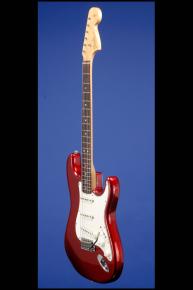Probably the Finest 1966 Candy Apple Red Stratocaster Extant.
1966 Fender Stratocaster.
This absolutely mint Candy Apple Red Stratocaster weighs 8.40 lbs. and has a nut width of just under 1 5/8 inches and a scale length of 25 1/2 inches. Solid alder body, contoured on back and lower bass bout. One-piece maple neck with a medium-to-thick profile. Veneer rosewood fretboard with 21 original medium frets and pearloid dot position markers. Single "butterfly" string tree with nylon spacer. Large headstock with 'Transition' logo with "Fender" in gold with black outline, "STRATOCASTER" in black beside it, "WITH SYNCHRONIZED TREMOLO" in black below it, and two patent numbers "2,741,146", "3,143,028" and "DES 169,062" below that. Individual 'double-line' Kluson Deluxe tuners with oval metal buttons and "D-169400 / Patent No." stamped on the underside. On the back of the headstock is a rectangular silver label - most probably from the original supplier. The label reads "Music House / 6837 Loch Raven Blvd, Baltimore, MD. / 360 Harundale Mall, Glen Burnie, MD." For fun, we researched the two addresses and found that the first one was a Music Store in the fifties and sixties. (It is now a Hunan Szechuan Chinese Restaurant) and the second one in Glen Burnie was in one of the first enclosed shopping malls which opened in 1958. Four-bolt neck plate with serial number "118998" between the top two screws. Three single-coil light gray bottom pickups with staggered polepieces and nicely matched outputs of 6.20k, 6.32k, and 6.03k. The undersides of the pickups have "12-21-66 16", "12-22-66 8" and "12-22-66 3" written in ink. Three-layer plastic pickguard (white/black/white) with eleven screws and full-size aluminium 'shield' on the underside. Three controls (one volume, two tone) plus three-way selector switch, all on pickguard. White plastic Stratocaster knobs with greenish gold lettering. Fender "Synchronized Tremolo" combined bridge/tailpiece. The neck is stamped "13 OCT 66 B"; the potentiometers are all stamped "137 6610" (CTS March 1966). There is one tiny chip (the size of a matchhead) on the on the lower edge of the treble bout. The original frets show some very slight wear - this guitar has been played - but certainly always babied! With this miniscule triviality said, this guitar is so mint - it is unbelievable. The color is rich and vibrant and shows no sign of fade whatsoever. By far the finest Candy Apple Red Stratocaster of any year that we have ever seen - A 9.50 rating does not do this guitar justice! Complete with the original tremolo arm and black leather Fender Guitar Strap. Housed in its original Fender black hardshell case with black leather ends and dark orange plush lining (8.75).
There are two letters "ES" stamped into the body between the middle pickup cavity and the bridge pickup cavity (only visible when the pickguard is removed) which signify that this guitar was "Enter Special" as with many other 1966 Fender guitars.
1966 and the "ES" Stamp. "The two-letter "ES" paint code means "Entered Special" for a special order or a show guitar. This does not indicate a factory refinish job, but was instead used by the factory to tell the finish booth to paint this body special order. Stamped number codes and letter codes mean different things… In 1966, Fender used the "ES" code a lot on their custom color instruments. At least for 1966, the ES code was used as some sort of default for custom colored instruments (be it Teles, or Strats or Jazz Basses). This two letters ("ES" for "Enter Special") seems to denote a special order, at least for 1966. Again this is has been seen lots of times on 1966 documented original custom color instruments." (http://www.provide.net/~cfh/fenderc.html)
"The Stratocaster was launched during 1954 [and was priced at $249.50, or $229.50 without vibrato]...The new Fender guitar was the first solidbody electric with three pickups [Gibson's electric-acoustic ES-5, introduced five years earlier, had been the overall first], meaning a range of fresh tones, and featured a new-design vibrato unit that provided pitch-bending and shimmering chordal effects. The new vibrato -- erroneously called a 'tremolo' by Fender and many others since -- was troublesome in development. But the result was the first self-contained vibrato unit: an adjustable bridge, a tailpiece, and a vibrato system, all in one. It wasn't a simple mechanism for the time, but a reasonably effective one...Fender's new vibrato had six bridge-pieces, one for each string, adjustable for height and length, which meant that the feel of the strings could be personalized and the guitar made more in tune with itself...The Strat came with a radically sleek, solid body, based on the outline of the 1951 Fender Precision Bass. Some musicians had complained to Fender that the sharp edge of the Telecaster's body was uncomfortable...so the Strat's body was contoured for the player's comfort… Even the jack socket mounting was new, recessed in a stylish plate on the body face...the Fender Stratocaster looked like no other guitar around especially the flowing, sensual curves of that beautifully proportioned, timeless body. The Stratocaster's new-style pickguard complemented the lines perfectly, and the overall impression was of a guitar where all the components ideally suited one another. The Fender Stratocaster has since become the most popular, the most copied, the most desired, and very probably the most played solid electric guitar ever" (Tony Bacon, 50 Years of Fender, p. 18).











